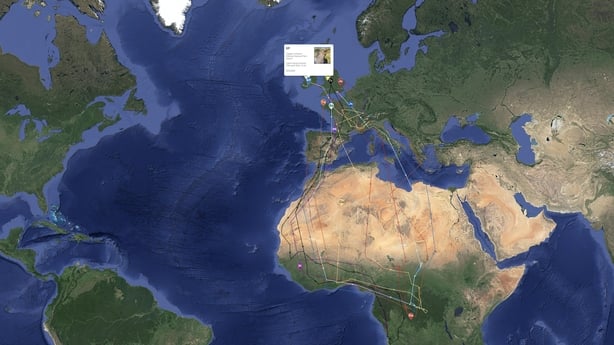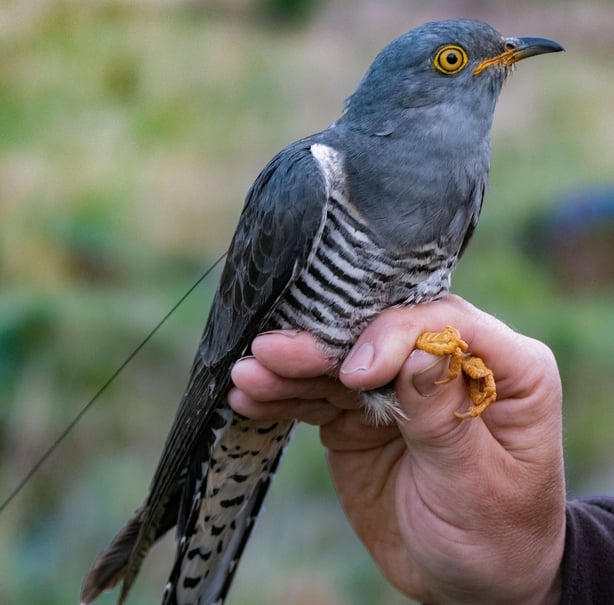One of the first Irish cuckoos tagged as part of the National Parks and Wildlife Service (NPWS) has returned home after a winter that took him as far as the rainforests in the Congo basin.
Last May, three Irish cuckoos were tagged in Killarney National Park to track their migration from Kerry and back again.
Cuach KP, the first of the three to complete the journey, has travelled 9,000 kilometres. The cuckoo made a quick stop in Fermoy in Cork before finding his way back to Killarney.
Mary Sheehan, NPWS district conservation officer based in Killarney National Park, heard her first cuckoo call of the year yesterday, on May Day.
She has been watching the three cuckoos tagged in Killarney last year with the Cuckoo Tracking Project since last year.
Ms Sheehan knew that Cuach KP, had come back to Kerry following a migration route that had taken him as far as the Democratic Republic of the Congo and back.

"This morning, I was up early, it was such a beautiful morning," Ms Sheehan said.
"The trees were a beautiful colour this time of year the leaves are so translucent and they're becoming different shades of green.
"The whole of Killarney National Park looks so fresh right now," she said.
Ms Sheehan was looking for Cuach KP near cliff sites where the birds are known to go in the park.
Cuckoos are famous for their unusual parenting style. Rather than make their own nests and care for their own young, cuckoos lay one egg each in the nest of other birds.
We need your consent to load this rte-player contentWe use rte-player to manage extra content that can set cookies on your device and collect data about your activity. Please review their details and accept them to load the content.Manage Preferences
In Ireland, cuckoos tend to favour Meadow Pipits as parents for their young. It is then Meadow Pipits who care for the cuckoo chick which will never meet its parents.
On Wednesday 1 May, Ms Sheehan went to where she could hear Meadow Pipits singing.
Then, she heard what she had been waiting for since last summer - the cuckoo’s call.
"Seeing that they were in a part of Africa and suddenly then they were in Spain and you're just waiting," she said.
"And other people are telling you they're hearing the cuckoo. But today, when I when I heard the cuckoo, I was just like, 'Yeah, you're back. You're back exactly where you were last year. And you've made that journey.’"
"And it was Mayday, it was so special.
Ms Sheehan added: "It was just the perfect day, perfect weather. It was a perfect time for hearing the cuckoo."
Cuckoos have been well-studied during breeding season however little is known about their migration routes or where they go in Africa for the winter months.

NPWS Conservation Officer and Director of the Cuckoo Tracking Project Sam Bayley has said the project was piloted last year and is being run in collaboration with the British Trust for Ornithology.
In Ireland, the cuckoo has seen a 27% reducing in breeding distribution between the first national census Bird Atlas (1968-1972), and the most recent Bird Atlas (2007-2011).
Speaking on RTÉ's Morning Ireland, he explained that Cuach KP was tracked from across Britain, France, Spain and Africa before ending up in the Congo basin.
"He arrived in Congo in about November and was there for about four months. And then in late February, he then shot off west towards the Guinea Bay Forest of Ghana and Sierra Leone in that sort of area and then did a massive jump back.
"And what was really exciting about this bird was it did something that no other cuckoo in Europe has been recorded doing before, and that was it did a big sea crossing.
"So, most of the birds end up sort of staying on the land and keeping through and making the shortest crossings of water they can. But this bird decided when it got to the north Spain, avoided going to France, avoided going to Britain and went straight to Ireland."






